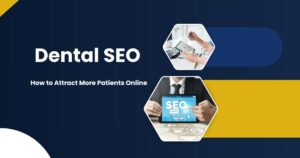What is SEO in Blogging? A Comprehensive Beginner’s Guide

In case you have recently started blogging or are contemplating doing so, you may have heard of SEO. However, just what is this SEO in blogging all about, and does at seemed as easy.
You will need good search engine optimization to make a huge difference on what sort and how much traffic comes to your blog. Without it, even if you are writing the most beautifully literate works in the world your post can disappear into what must be considered as a geomagnetic field.World, here is everything you need to know about blogging SEO: what it is, how it works, and why a successful blogger can’t do without it.
What is SEO, and Why Does it Matter for Blogging?
SEO, or Search Engine Optimization, refers to the process of optimizing your blog posts and website so they appear higher in search engine results pages (SERPs). Simply put, it’s how you ensure people can find your blog when they search for topics you write about.
Why Does SEO Matter for Blogs?
If you’re wondering why SEO is crucial, here are three quick reasons:
- Visibility: The higher your blog appears in search results, the more likely people are to click on it.
- Organic Traffic: SEO helps you bring in traffic organically, without having to rely on paid ads.
- Audience Targeting: By using SEO techniques, you attract readers who are specifically searching for content you provide, ensuring a more engaged audience.
For example, if you’re a food blogger writing about “quick pasta recipes,” optimized SEO ensures your post shows up when people search for that keyword.
Key Elements of SEO in Blogging
To truly succeed with SEO, it’s important to understand the key elements that form its foundation. These touch on various aspects of content creation, structure, and technical optimization. Here’s a breakdown:
1. Keywords
Keywords are the backbone of SEO. These are the words and phrases people type into search engines to find what they’re looking for. For example, if your blog post is about “how to bake sourdough bread,” relevant keywords could include:
- “sourdough bread recipe”
- “homemade sourdough tips”
- “starter for sourdough bread”
How to Find Keywords
Use tools like Google Keyword Planner, Ubersuggest, or Ahrefs to research keywords. Look for phrases with decent search volume and low competition, especially if you’re just starting out.
2. High-Quality Content
No amount of optimization can rescue poor content. Search engines, especially Google, prioritize content that adds value and satisfies user intent. This means your blog posts should:
- Address a specific question or problem.
- Provide thorough, accurate, and engaging information.
- Be well-structured and easy to read.
For example, a well-optimized post about “beginner yoga tips” should provide actionable advice, step-by-step instructions, or even a beginner-friendly sequence.
3. On-Page SEO
On-page SEO refers to all the elements on your blog that you can optimize. These include:
- Title Tags: Your blog title should include your main keyword and entice people to click.
- Meta Descriptions: This short summary (up to 155 characters) shows up in search results and should highlight what your post is about.
- Headings (H1, H2, H3): Structure your post with headings and include keywords naturally within them.
- Internal Links: Link to other relevant posts on your blog to keep readers engaged and improve crawlability.
- Image Optimization: Use alt text for images; this helps visually impaired users and enhances search ranking.
4. Technical SEO
While this might sound intimidating, some basic technical SEO tasks are easy to implement, such as:
- Mobile Optimization: Ensure your blog looks great and functions well on mobile devices. This is crucial since over 60% of web traffic comes from mobile users.
- Page Speed: Optimize your site for fast loading times by compressing images and using caching plugins.
- SSL Certificate: Secure your site with HTTPS to improve both ranking and user trust.
5. Backlinks
Backlinks are links to your blog from other credible websites. They signal to Google that your content is authoritative and trustworthy. Build backlinks by:
- Writing guest posts for other blogs.
- Creating shareable, high-quality content that others want to reference.
- Collaborating with influencers in your niche.
6. User Engagement
Search engines consider user engagement data, like bounce rates and time spent on a page, to measure how valuable your content is. To boost engagement:
- Write a compelling introduction to hook readers.
- Use visuals like images, videos, and infographics to break up text.
- Include calls to action, such as “Subscribe to our newsletter!” or “Comment below with your thoughts.”
How to Optimize a Blog Post for SEO in 5 Steps
Now that you know the foundational elements, here’s a step-by-step guide to putting them into practice:
Step 1. Choose Your Target Keyword
Pick a keyword that aligns with your blog topic. Make sure it has a good mix of search volume and relevance to your audience.
Step 2. Craft an SEO-Friendly Title
Your title should include your target keyword and grab attention. For example:
- Target keyword: “SEO in blogging”
- Title idea: “SEO in Blogging Made Simple: Boost Your Traffic Today”
Step 3. Create a Killer Meta Description
Write a short, engaging summary of your post (no more than 155 characters) using your keyword. Example:
- “Learn SEO in blogging! This guide covers the essentials to help you optimize content, increase visibility, and boost traffic.”
Step 4. Use Keywords Strategically
Sprinkle your keyword throughout the blog, including:
- The first 100 words.
- At least one subheading.
- Image alt text.
- The conclusion.
However, avoid overstuffing keywords, as this can hurt your SEO and readability.
Step 5. Include Clear Calls to Action
Guide readers toward a specific next step, whether it’s subscribing to your newsletter, sharing the post, or reading another article. This keeps users engaged and helps reduce bounce rates.
Blogging + SEO = Endless Opportunities
In blogging SEO is more than just a term for the which is fashionable. It is a tool which can convert your personal passion blog into a profitable business.
By optimizing your content, you are not only increasing traffic but also connecting with your ideal audience in a meaningful way.
Using the tips you’ve learnt in this guide, and you’ll see a higher ranking for your blog, greater reach, and lasting benefits.
Do you want more practical help with your blog’s SEO strategy? Sign up for our newsletter and get tips that will elevate your blogging.








